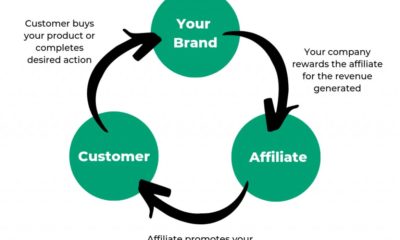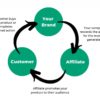Affiliate Marketing
How do Affiliate Links Work?
If you’ve ever bought anything online then you’ve probably bought something through someone’s affiliate link and I am betting you never even knew it.
I get asked almost on a daily basis about how/what affiliate links are and in this post I am going to answer the question: How do Affiliate Links Work? More importantly, I will illustrate how you should use affiliate links. 😉
How Do Affiliate Links Work?
Affiliate links are just like any other link on the web, but when you click an affiliate link it will save a cookie onto the web browser and computer you’re using (a “browser cookie” or simply “cookie,” is a small piece of data sent from a website and stored in the user’s web browser while the user is browsing the website).
It saves some information about where you came from and tells the site/shop “Hey shop, this reader has clicked on a link from this blogger; if they buy something, make sure you record how much they spent on the site.”
The cookie that’s saved to your computer also lets the site you visited know who you are the next time you visit the site and buy something.
The cookie stays active for a certain period — usually 30 days time, but sometimes longer. Here’s an affiliate link of mine that takes you to BlueHost — scotthurtado.com/bluehost
Now, what happens when you click that link is you’re taken to BlueHost and if you purchase anything from BlueHost within 90 days, BlueHost will give me credit because you clicked through my link and purchased something.
Affiliate links basically track when someone clicks and then save a cookie to make sure you’re credited when someone makes a purchase.
What Is Affiliate Marketing?
Even though I’ve answered this question in many of my posts on the site, it’s always nice to include it in as many posts that touch on the subject. Wikipedia says that affiliate marketing works like this:
Affiliate marketing is a marketing practice in which a business rewards one or more affiliates for each visitor or customer brought about by the affiliate’s own marketing efforts.
Now you can pretty much place your affiliate links anywhere you like on the web, but what I don’t like is when people recommend something using their affiliate links when I know they’ve never used the product before. Not only have they never used the product, but they also try to hide the fact that they’re using their affiliate link just to make a quick buck.
A great example of this little trick tactic that a lot of sites use is when you search Google for a coupon code for something. When you go to Google and search for a coupon code, a bunch of sites will come up claiming that you can get a discount.
What most people do is click on the site and see a big list of coupon codes that you must click on in order to unlock the coupon.
Sometimes they will have a legitimate coupon code, but a lot of the time they don’t have anything that will give you a discount. What’s happening is they’re using their own affiliate links telling you to click through and you will be discounted when all that’s really happening is the coupon site is getting commissions by referring you to the site where you want to make a purchase.
It makes some people mad (myself included) that you didn’t get a coupon code let alone them making money off you for clicking through their affiliate link.
Now don’t get me wrong, not all affiliate marketing is using the dark side. For example, when I create content I recommend a wide selection of tools, services, and products because it’s not only what I use within my business, it’s stuff that I truly love. BlueHost is a great example and when someone clicks through my link to be taken to BlueHost I will earn a commission from them. learn more about making contextual backlinks naturally.
What I try to make apparent to people that click through my affiliate links is that I am earning a commission. Now what I don’t do is try to trick people to click through my links. It’s just not my style and if that were the case I would promote something else other than BlueHost because there are other hosting companies that will pay me 2-3x more per referral compared to what BlueHost pays out.
The coupon sites that you see throughout the web are a great example of using trickery to get referrals.
In a past article, I wrote about How To Properly Disclose Your Affiliate Links.
It’s something I highly recommend you check out because not only will you earn more by being upfront about your affiliate links, you will not be tricking people into clicking your links to make a quick buck (which is annoying as hell).

Where Do You Sign Up to Be an Affiliate?
There are about a gazillion affiliate programs out there for you to start promoting and earning a commission when a purchase is made through your affiliate link.
Some of the affiliates I use are on their own affiliate platform — meaning that you sign up through their main website. Others are on affiliate networks like CJ.com and ShareaSale.com
If you like a particular product then perform a Google search like this:
It’s not hard to find an affiliate program for almost anything you can imagine you can find web designer Ireland affiliate links. If you can’t seem to find their sign-up page to become an affiliate and get an affiliate link of your own, then you can contact them and ask if they have an affiliate area where you can sign up.
How Exactly Do I Get People to Click Through Them?
Making sure you’ve placed your links in the right places is going to make or break you in regards to earning commissions with your affiliate links.
There are about a million places for you to place an affiliate link not only on your site, but also on the web (social updates, emails, other sites, forums, and a load of other places).
One might think that you should just spam your link to every corner of the web. Now I don’t recommend you do this because it’s not only annoying to the end-user, it’s not going to work as well as you might think. Yes, having your link in as many places as possible would get you thinking it’s going to get more clicks and that might be the case, but it’s not going to get you sales — meaning someone actually buying the offer after clicking through your link.
The entire point to strategically placing your affiliate links is to get someone to buy. I say that you should always try to link to an affiliate that you use yourself or one that you have an interest in.
There are those affiliates on the web that seem to promote anything and everything that they can to make a quick buck and the commission numbers might seem great, but who is going to buy it when you yourself haven’t bought it? Well, no one.
Places to put your links:
1. The number one place on my site where I earn affiliate commissions is my resource page — scotthurtado.com/resources
This page is a page I created that lists all the tools and resources I use and recommend. All of them are great and I stand 100% behind these businesses. Heck, without some of the tools listed on that page I wouldn’t be able to do what I do, so that should tell you how much I love them all.
2. Within the content itself, blog posts, eBooks, videos, and everything you create are great places to throw in your affiliate links.
3. Site sidebar. Your sidebar is premium real estate for your affiliate links and if you love a product, put it within your site’s sidebar. This is also a great place for Banner Ads like Google AdSense and BuySellAds.
4. Place them within products and services. If you’ve been on the web for some time I am sure you’ve seen companies offering discounts when you buy using their promo codes or clicking through their links and this is because they earn a kickback when you do.
If you’re inside my Program then you’ve probably seen me use affiliates within my stuff and that’s because it works. 😉
5. Live events. Doing live events drives sales and revenue like nothing else out there! If you’re talking to a group of people for hours at a time then tell them to sign up for x, y, and z through your affiliate links.
The ones that are engaged will take you up on the offer and buy through your link. Also, I’ve seen that when you tell people it’s your affiliate link they will be happier about the purchase than if you were to try and hide that fact.
The First Click/Last Click Battle
To those of you that are new to affiliate links and how they work, this next part might be a little confusing. So … sorry about that. 😉
As you’ve been reading you should now know that once your affiliate link is clicked through by someone, a cookie will be saved onto their computer. As I stated earlier, the cookie will be used to give you credit when you make a purchase.
However, this is where it’s going to get a little complicated, which happens all the time. So … try to pay attention ’cause this stuff matters.
You’ve placed an affiliate link on your site and someone clicks through to buy, but for some reason, they leave the site and start browsing the web for something else that interests them and start reading someone else’s site that talks about the same product you had an affiliate link for. And if you remember, this person already clicked through your affiliate link so they now have a cookie saved on their computer that has your affiliate ID on it so you can get paid when they purchase.
Now that the person has read more info on the product, they click through that site’s link to go buy, which is a different affiliate link. Now in the case of them already having your affiliate link cookie and then clicking a new affiliate link, who does the sale go to?
If they click your affiliate link and don’t buy right away but later that same day or next week click another affiliate link that sends them to the same page, who then gets the credit?
Well, some affiliate programs credit the first link click while others will credit the last link click. I know it’s a little bit of technical jargon that’s not all too fun to read, but hey, it’s your business we’re talking about here and you should learn as much as possible about the subject.
A quick tip: Use a link shortening tool like PrettyLinks which will turn links like this:
into a link that looks like this: http://scotthurtado.com/Wacom
Like I’ve talked about in past posts, it’s a lifesaver because no one wants to remember that first link.
One last tip that I want to mention, you should always track your affiliate links when you run multiple campaigns or even place the same link in two places.
For example, let’s say I throw my affiliate link in an email and also post it up to Twitter, Facebook, and Instagram and I make a few sales. The only way to tell which platform the sales came from is by using tracking software.
There’s one that I recommend you pick up and it’s LinkTrackr. I’ve used others before, but this one is by far my favorite. You can open an account through my affiliate link and get a 25% discount for a yearly sign-up: scotthurtado.com/linktrackr and scotthurtado.com/clickmeter
Conclusion
Affiliate links are not complicated; don’t get hung up on the tech side of it. It’s simple — when someone clicks your link and buys within the cookie duration you will get a commission payout.
It’s an amazing way to not only make a few extra bucks a month, but you can also make a few extra million a year. 🙂
All that I must say is keep the end-user in mind with your promotions. If you think a product or service that you’re affiliated with would benefit someone, then send them your affiliate link.
Thanks so much for reading; please share your thoughts on what’s working for you in your affiliate marketing efforts. What do you like/dislike about affiliate links?











